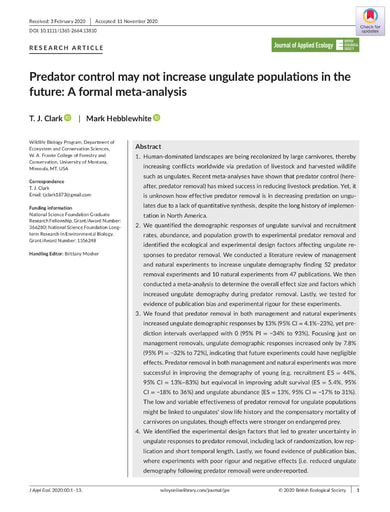pdf 20-11 Clark-Hebblewhite - Predator Control Popular
By Catarina Owen 2042 downloads
20-11 Clark-Hebblewhite - Predator Control.pdf

Abstract
1. Human-dominated landscapes are being recolonized by large carnivores, thereby increasing conflicts worldwide via predation of livestock and harvested wildlife such as ungulates. Recent meta-analyses have shown that predator control (hereafter, predator removal) has mixed success in reducing livestock predation. Yet, itis unknown how effective predator removal is in decreasing predation on ungulates due to a lack of quantitative synthesis, despite the long history of implementation in North America.
2. We quantified the demographic responses of ungulate survival and recruitment rates, abundance, and population growth to experimental predator removal and identified the ecological and experimental design factors affecting ungulate responses to predator removal. We conducted a literature review of management and natural experiments to increase ungulate demography finding 52 predator removal experiments and 10 natural experiments from 47 publications. We then conducted a meta-analysis to determine the overall effect size and factors which increased ungulate demography during predator removal. Lastly, we tested for evidence of publication bias and experimental rigour for these experiments.
3. We found that predator removal in both management and natural experiments increased ungulate demographic responses by 13% (95% CI = 4.1%–23%), yet prediction intervals overlapped with 0 (95% PI = −34% to 93%). Focusing just on management removals, ungulate demographic responses increased only by 7.8%(95% PI = −32% to 72%), indicating that future experiments could have negligible effects. Predator removal in both management and natural experiments was more successful in improving the demography of young (e.g. recruitment ES = 44%,95% CI = 13%–83%) but equivocal in improving adult survival (ES = 5.4%, 95%CI = −18% to 36%) and ungulate abundance (ES = 13%, 95% CI = −17% to 31%).The low and variable effectiveness of predator removal for ungulate populations might be linked to ungulates' slow life history and the compensatory mortality of carnivores on ungulates, though effects were stronger on endangered prey.
4. We identified the experimental design factors that led to greater uncertainty in ungulate responses to predator removal, including lack of randomization, low replication and short temporal length. Lastly, we found evidence of publication bias, where experiments with poor rigour and negative effects (i.e. reduced ungulate demography following predator removal) were under-reported.
5. Synthesis and Applications. We recommend future predator removal experiment Synthesis and Applications. We recommend future predator removal experiments be conducted with a more rigorous experimental design to overcome these weaknesses, especially for endangered species where predator removal may work more effectively. We suggest that managers attempting to evaluate experimental practices to increase ungulate populations through predator removal could employ an open standards framework akin to the ‘Open Standards for the Practice of Conservation’ framework.


 Phone: 867-374-4040
Phone: 867-374-4040 Email:
Email: